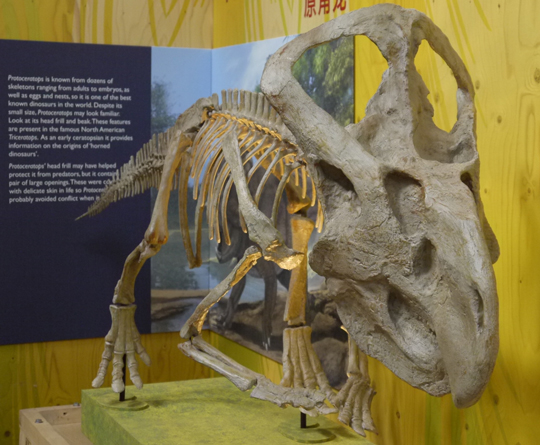Horned Dinosaurs Evolved Frills to Attract Mates
The ornate and very diverse head crests and frills of horned dinosaurs (ceratopsians) probably evolved to help them attract a mate. That is the conclusion from a study recently published in the Proceedings of the Royal Society B.
Why Did Some Horned Dinosaurs Have Elaborate Frills?
Ever since the first horned dinosaurs were discovered, palaeontologists have debated why these plant-eating dinosaurs evolved such elaborate neck shields (these features are produced by elaborate extensions to the parietal and squamosal skull bones). It had been thought that these frills provided some protection from attack from theropod dinosaurs such as the contemporaneous tyrannosaurs, or perhaps they had a role in thermoregulation.
With so many different types of large ceratopsians known from the Late Cretaceous of North America it had also been suggested that these crests and frills played a role in species recognition. An extensive analysis of the skulls of “first horned face” – Protoceratops (P. andrewsi), suggests that they played a role in sexual selection.
A Reconstruction of the Skeleton of Protoceratops (P. andrewsi)

A skeleton of a Protoceratops on display. The elaborate head crest complete with fenestrae (two large holes), probably evolved as a result of sexual selection. Picture credit: Everything Dinosaur.
Picture credit: Everything Dinosaur
Sexual Selection in Horned Dinosaurs
Sexual selection is a method of natural selection in which members of one biological sex choose mates of the other sex to mate with. Certain characteristics in organisms are favoured by members of the opposite sex and organisms that possess the favoured feature(s) are the ones that breed. This leads over time to these preferred characteristics becoming more intricate and elaborate. There are plenty of examples to be found in the natural world today, most certainly amongst the closest living relatives of the Dinosauria the birds. The elaborate but cumbersome tails of peacocks for instance, or the ornate and very beautiful plumes of the birds of paradise.
The researchers, which included scientists from the Natural History Museum (London) and Queen Mary University of London, used computer modelling to map how the skull of Protoceratops changed as the dinosaur grew. Protoceratops has a rich and extensive fossil record. Hundreds of specimens have been found ranging from embryos in unhatched eggs up to large, very old adults. This extensive fossil record made this type of horned dinosaur an ideal candidate for this study.
The Fossilised Remains of a Protoceratops

Protoceratops fossil display in Frankfurt Museum (could be a cast). Picture credit: Everything Dinosaur.
Picture credit: Everything Dinosaur
An Important Driver of Evolution
Sexual selection is predicted to be an important driver of evolution. It influences adaptation and the development of new species. There are anatomical traits and characteristics that can be identified in the fossil record that indicate sexual selection within a species is at work. The fossilised skulls of horned dinosaurs can be studied to see if any of these traits and characteristics can be found.
Predicted characteristics of horned dinosaur skulls that indicate sexual selection having an influence include:
- Low integration with the rest of the skull.
- A significantly higher rate of change in size and shape as the dinosaur grows.
- A higher morphological variance in the parietal and squamosal when compared to other bones of the skull.
The computer modelling used to assess these traits supported the theory that sexual selection was at work within Protoceratops andrewsi.
No Evidence of Sexual Dimorphism in Protoceratops
Whilst it is notoriously difficult to identify males from females using just the fossil record, the large number of Protoceratops specimens gave the researchers the opportunity to see if they could spot evidence of male Protoceratops having different skull frills compared to the females. Although the research involved a substantial sample set, no evidence of sexual dimorphism in skull shape was found. This suggests that either there were no differences in frill shape between the boys and the girls or that any differences between the genders was very small.
A Model of an Adult Protoceratops
Picture credit: Everything Dinosaur
The image (above) shows a Papo Protoceratops dinosaur model.
To view the Papo dinosaur model range: Papo Dinosaurs and Prehistoric Animal Models.
The scientific paper supports the idea that the elaborate frills of horned dinosaurs did play a role in sexual selection. Scientists have suspected that many of these strange anatomical features found in the Dinosauria were linked to sexual selection and display. This evidence is extremely hard to find using the fossil record alone, however, the computer modelling and in-depth analysis used here provides evidence for the presence of signalling structures linked to sexual selection in Protoceratops andrewsi.
The scientific paper: “Three-dimensional geometric morphometric analysis of the skull of Protoceratops andrewsi supports a socio-sexual signalling role for the ceratopsian frill” by A. Knapp, R. J. Knell and D. W. E. Hone published in the Proceedings of the Royal Society B.
Visit the Everything Dinosaur website: Everything Dinosaur.







Leave A Comment